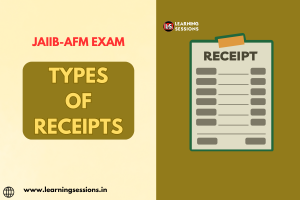The Junior Associate of Indian Institute of Bankers (JAIIB) certification equips bankers to understand and apply core banking concepts. The Accounting and Financial Management for Bankers (AFM) module includes important topics, such as Types of Receipts, which are fundamental for managing and interpreting a bank’s financial transactions. Learning Sessions will take you through this article that delves into the concept of types of receipts and how to approach case studies on this topic with a focus on practical applications.

📚 JAIIB Study Resources 📚
👉 Check Here
👉 Check Here
👉 Check Here
👉 Get Tests Here
👉 Check Here
DOWNLOAD PDF TYPES OF RECEIPTS -CASE STUDY
Receipts are the inflows of money into an organization, classified broadly into two categories:
-Capital Receipts: These are non-recurring in nature and are often linked to financing or investment activities. They do not arise from the regular operations of the business and are generally recorded in the balance sheet.
Examples: Proceeds from issuing shares, loans raised by the bank, and sale of fixed assets.
-Revenue Receipts: These are recurring inflows derived from the organization’s core operational activities. They are recorded in the income statement and contribute to the current year’s income.
Examples: Interest earned on loans, commission income, and service charges.
For the extensive preparation of candidates, get details through our YouTube videos for JAIIB AFM Module wise Syllabus with explanations and tips to help candidates in their preparation journey.
You may also like these JAIIB case studies:
JAIIB | AFM | REGULATION OF DERIVATIVE MARKET
JAIIB | AFM | TYPES OF FINANCIAL DERIVATIVE PRODUCTS
In the banking context, understanding these receipts is critical for accurate financial reporting and decision-making.
For banking professionals, differentiating between capital and revenue receipts is vital for several reasons:
- Accurate Financial Reporting: Ensures proper classification and presentation in financial statements.
- Decision-Making: Helps in evaluating the sustainability of income sources and financial health.
- Regulatory Compliance: Aligns financial practices with guidelines issued by the Reserve Bank of India (RBI).
- Performance Analysis: Distinguishes between operational efficiency and long-term financial strategies.
In the end, the Types of Receipts topic in the JAIIB AFM module provides relevant insights into financial management and accounting practices. By considering case studies and theoretical concepts, applicants can build up their professional expertise and contribute effectively to their organizations. Learning Sessions provides additional information about JAIIB AFM GOODS & SERVICE TAX (GST) by giving examples of real life scenarios.
Learn more about this case study through our YouTube channel and PDF.
Get access to our Telegram Channel for free Pdfs of JAIIB.







